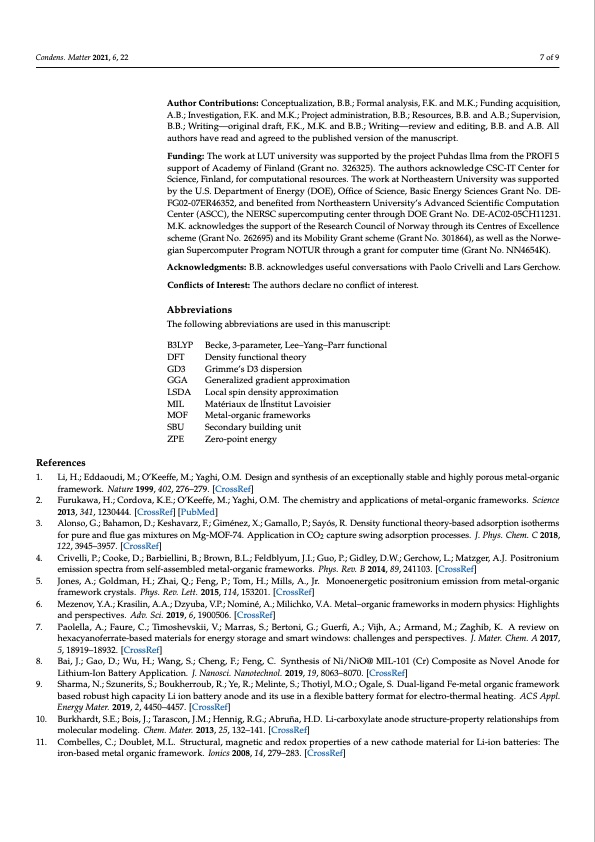
PDF Publication Title:
Text from PDF Page: 007
Condens. Matter 2021, 6, 22 7 of 9 References Author Contributions: Conceptualization, B.B.; Formal analysis, F.K. and M.K.; Funding acquisition, A.B.; Investigation, F.K. and M.K.; Project administration, B.B.; Resources, B.B. and A.B.; Supervision, B.B.; Writing—original draft, F.K., M.K. and B.B.; Writing—review and editing, B.B. and A.B. All authors have read and agreed to the published version of the manuscript. Funding: The work at LUT university was supported by the project Puhdas Ilma from the PROFI 5 support of Academy of Finland (Grant no. 326325). The authors acknowledge CSC-IT Center for Science, Finland, for computational resources. The work at Northeastern University was supported by the U.S. Department of Energy (DOE), Office of Science, Basic Energy Sciences Grant No. DE- FG02-07ER46352, and benefited from Northeastern University’s Advanced Scientific Computation Center (ASCC), the NERSC supercomputing center through DOE Grant No. DE-AC02-05CH11231. M.K. acknowledges the support of the Research Council of Norway through its Centres of Excellence scheme (Grant No. 262695) and its Mobility Grant scheme (Grant No. 301864), as well as the Norwe- gian Supercomputer Program NOTUR through a grant for computer time (Grant No. NN4654K). Acknowledgments: B.B. acknowledges useful conversations with Paolo Crivelli and Lars Gerchow. Conflicts of Interest: The authors declare no conflict of interest. Abbreviations The following abbreviations are used in this manuscript: B3LYP Becke, 3-parameter, Lee–Yang–Parr functional DFT Density functional theory GD3 Grimme’s D3 dispersion GGA Generalized gradient approximation LSDA Local spin density approximation MIL Matériaux de lÍnstitut Lavoisier MOF Metal-organic frameworks SBU Secondary building unit ZPE Zero-point energy 1. Li, H.; Eddaoudi, M.; O’Keeffe, M.; Yaghi, O.M. Design and synthesis of an exceptionally stable and highly porous metal-organic framework. Nature 1999, 402, 276–279. [CrossRef] 2. Furukawa, H.; Cordova, K.E.; O’Keeffe, M.; Yaghi, O.M. The chemistry and applications of metal-organic frameworks. Science 2013, 341, 1230444. [CrossRef] [PubMed] 3. Alonso, G.; Bahamon, D.; Keshavarz, F.; Giménez, X.; Gamallo, P.; Sayós, R. Density functional theory-based adsorption isotherms for pure and flue gas mixtures on Mg-MOF-74. Application in CO2 capture swing adsorption processes. J. Phys. Chem. C 2018, 122, 3945–3957. [CrossRef] 4. Crivelli, P.; Cooke, D.; Barbiellini, B.; Brown, B.L.; Feldblyum, J.I.; Guo, P.; Gidley, D.W.; Gerchow, L.; Matzger, A.J. Positronium emission spectra from self-assembled metal-organic frameworks. Phys. Rev. B 2014, 89, 241103. [CrossRef] 5. Jones, A.; Goldman, H.; Zhai, Q.; Feng, P.; Tom, H.; Mills, A., Jr. Monoenergetic positronium emission from metal-organic framework crystals. Phys. Rev. Lett. 2015, 114, 153201. [CrossRef] 6. Mezenov, Y.A.; Krasilin, A.A.; Dzyuba, V.P.; Nominé, A.; Milichko, V.A. Metal–organic frameworks in modern physics: Highlights and perspectives. Adv. Sci. 2019, 6, 1900506. [CrossRef] 7. Paolella, A.; Faure, C.; Timoshevskii, V.; Marras, S.; Bertoni, G.; Guerfi, A.; Vijh, A.; Armand, M.; Zaghib, K. A review on hexacyanoferrate-based materials for energy storage and smart windows: challenges and perspectives. J. Mater. Chem. A 2017, 5, 18919–18932. [CrossRef] 8. Bai, J.; Gao, D.; Wu, H.; Wang, S.; Cheng, F.; Feng, C. Synthesis of Ni/NiO@ MIL-101 (Cr) Composite as Novel Anode for Lithium-Ion Battery Application. J. Nanosci. Nanotechnol. 2019, 19, 8063–8070. [CrossRef] 9. Sharma, N.; Szunerits, S.; Boukherroub, R.; Ye, R.; Melinte, S.; Thotiyl, M.O.; Ogale, S. Dual-ligand Fe-metal organic framework based robust high capacity Li ion battery anode and its use in a flexible battery format for electro-thermal heating. ACS Appl. Energy Mater. 2019, 2, 4450–4457. [CrossRef] 10. Burkhardt, S.E.; Bois, J.; Tarascon, J.M.; Hennig, R.G.; Abruña, H.D. Li-carboxylate anode structure-property relationships from molecular modeling. Chem. Mater. 2013, 25, 132–141. [CrossRef] 11. Combelles, C.; Doublet, M.L. Structural, magnetic and redox properties of a new cathode material for Li-ion batteries: The iron-based metal organic framework. Ionics 2008, 14, 279–283. [CrossRef]PDF Image | Electrochemical Potential MIL-101(Fe) as Cathode Material in Li-Ion Batteries

PDF Search Title:
Electrochemical Potential MIL-101(Fe) as Cathode Material in Li-Ion BatteriesOriginal File Name Searched:
condensedmatter-06-00022.pdfDIY PDF Search: Google It | Yahoo | Bing
Sulfur Deposition on Carbon Nanofibers using Supercritical CO2 Sulfur Deposition on Carbon Nanofibers using Supercritical CO2. Gamma sulfur also known as mother of pearl sulfur and nacreous sulfur... More Info
CO2 Organic Rankine Cycle Experimenter Platform The supercritical CO2 phase change system is both a heat pump and organic rankine cycle which can be used for those purposes and as a supercritical extractor for advanced subcritical and supercritical extraction technology. Uses include producing nanoparticles, precious metal CO2 extraction, lithium battery recycling, and other applications... More Info
| CONTACT TEL: 608-238-6001 Email: greg@infinityturbine.com | RSS | AMP |